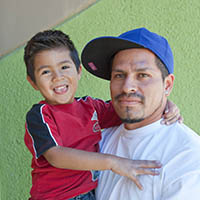
Ideally, team members will be able to communicate with families in their primary language; if this is not feasible, make sure to have interpreters available. One possible strategy is to have family advocates or home visitors distribute and collect family surveys. If they can directly assist adults who have reading difficulties or who prefer an interview format, this will increase the survey response rate and support the staff person's involvement in the process.
As you plan to conduct the community assessment, make sure to understand and observe the social customs and practices of families whose cultural and linguistic backgrounds differ from your own. Some populations may be cautious about engaging with you, particularly if they don't know why you are approaching them. In these situations, seek out trusted individuals who can introduce you rather than simply showing up and introducing yourself.
There is no one correct approach to interacting with people from different backgrounds; expectations around personal interactions are as many and as diverse as the groups involved. For example, individuals from some cultures may expect interactions with you to be reciprocal, with you beginning by sharing something about yourself, your family, your affiliations, and where you are from. In these situations, allow time to get acquainted before moving on to business. It is important to build an in-depth understanding of how to effectively and respectfully interact with people from a wide range of cultures. You will not only obtain more useful feedback and data, but you will also establish a foundation for engaging diverse groups in the life of your program after the community assessment is completed.
Collecting data related to community resources and strengths can be particularly challenging. The best advice is to build strong relationships with community agencies and maintain ongoing contact with them. Then, when it is time for the community assessment, they are more likely to participate in the process and provide useful information. In fact, representatives from community organizations might be willing to serve on your team.
There are a number of strategies that might help you collect information about community resources. Send a brief questionnaire to a large number of agencies. The strategy is to use a short questionnaire that is not time-consuming and to reach many agencies because a low response rate is likely. You can include a stamped, self-addressed envelope as an incentive to respond. You can follow up with phone calls or interviews when an agency does return the questionnaire.
By building an in-depth understanding of how to effectively and respectfully interact with people from a wide range of cultures, you will establish a foundation for engaging diverse groups in your program after the community assessment is completed.

New Director Tip
On-the-Ground Perspective
Consider the benefits of systematically walking or driving through your service area. This provides a firsthand understanding of public transit access, movement patterns, and cultural resources.
Photographs and maps from the service area can humanize the data and visually highlight key resources and needs.

What new cultural groups have joined your service area since your program's last community assessment? How will you address their communication needs during the next community assessment?
Read more:
Resource Type: Article
National Centers: Program Management and Fiscal Operations
Audience: Directors and Managers
Last Updated: February 4, 2025
